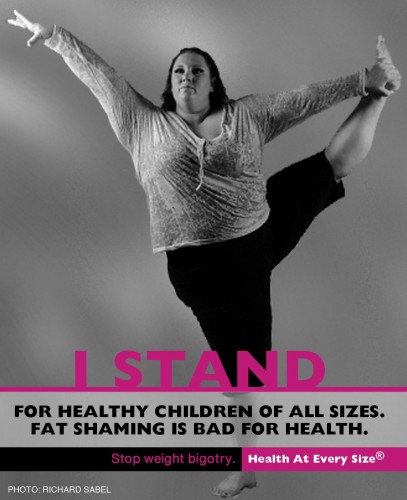
Last week I delineated Schraube’s concept of technology as materialized action—or the notion that material objects are simultaneously imbued with human subjectivity while independently affecting human experience. I concluded by noting that this relationship between built-in agency and independent efficacy makes the object necessarily precarious—leading often to unimagined consequences.
With this precariousness in mind, I want to focus here on the body as technology, and specifically I want to focus on the body as a potentially politicized technology. I do so using the case of body size.
The body is simultaneously infused with human meaning and independent efficacy. The body is an object created out of human choices about (literal) consumption, adornment, and sculpture. At the same time, the body tells the person to ‘eat this, wear that, desire hir, move like this.’ The body then, as materialized action, is necessarily precarious. We cannot know what affect the relationship between the person and hir body will produce. Does a thin body reflect and affect fitness, or does it reflect and affect poor body image and restrictive self-control? Does a fat body reflect and affect indulgence, or does it reflect and affect acceptance and pleasure?
To embrace this ambivalence, I argue, is the means by which the body—as a technology—can be transformed into a politicized tool. Such a transformation is exemplified in the Fat Positive movements. Fat Positive movements exist in juxtaposition to narrow (pun intended) beauty standards that not only exclude the majority of U.S. women, but bring about anxiety, guilt, and sometimes dangerous behaviors of voluntary starvation, purging, and/or excessive exercise. Importantly, these sensibilities (a privileging of thinness and its behavioral and psychological consequences) are largely produced through the (often institutionally facilitated) accomplishment of thinness, and the public display of thin bodies. Fat Activists, in contrast, imbue (often their own) bodies with different meaning.

In a culture in which thin is deemed not only beautiful, but also moral, a fat woman in a bikini is a radical act. Embracing this radicalism, Fat Activists proudly display, maintain, and/or publicly support large bodies. In doing so, they use these bodies as objects to affect an explicit kind of change—that of both ideology and behavior—which they hope will alter the subjectivity imbued in future bodies.
In short, with materialized action as a framework, we have a language with which to talk about the body as a tool, one full of human agency with the potential for imagined, and unimaginable, effects. As a politicized technology, the body can be used to challenge not only fatness (as described here), but heteronormativity, binary gender categories,ableism, and white racial privilege. We should be warned, however, that the ambivalence of artifacts, with their potential for unimagined effects, means that the body—like all technologies—can be used for both revolutionary change (e.g. Fat Activism) AND stagnant, sometimes repressive, reification (e.g. Thinspiration). Indeed, the latter is far more common than the former, as it is only through recognition of the body as an object of materialized action, coupled with a propensity for change, that such stagnation can be fought.
Jenny Davis is a Doctoral Candidate in the Department of Sociology at Texas A&M University. Follow Jenny on Twitter @Jup83


Comments 1
Desiree — July 1, 2012
love love love it, .. My new favorite space is now Cyborgology - I found my home. :-) Fabulous Work, I cannot wait to regurgitate. :-) ~Technospunky